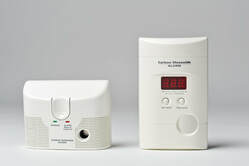
According to UL Standard 2034, home carbon monoxide detectors must sound a warning before carbon monoxide levels reach 100 parts per million over 90 minutes, 200 parts per million over 35 minutes or 400 parts per million over 15 minutes.
The standard requires the alarm must sound before an average, healthy adult begins to experience symptoms of carbon monoxide poisoning. The warning provides time to evacuate the premises.
Proper placement of a carbon monoxide detector is important. If you are installing only one carbon monoxide detector, the Consumer Product Safety Commission (CPSC) recommends it be located near the sleeping area, where it can wake you if you are asleep. Additional detectors on every level and in every bedroom of a home will provide extra protection.
Homeowners should remember not to install carbon monoxide detectors directly above or beside fuel-burning appliances, as appliances may emit a small amount of carbon monoxide upon start-up. A detector should not be placed within fifteen feet of heating or cooking appliances or in or near very humid areas such as bathrooms.
When considering where to place a carbon monoxide detector, keep in mind that although carbon monoxide is roughly the same weight as air (carbon monoxide’s specific gravity is 0.9657, as stated by the EPA; the National Resource Council lists the specific gravity of air as one), it may be contained in warm air coming from combustion appliances such as home heating equipment. If this is the case, carbon monoxide will rise with the warmer air.
For this reason, the makers of First Alert®, the leading brand in carbon monoxide detector technology, suggests mounting the detector on the ceiling. This also puts the detector out of the way of potential interference, such as pets or curious children.
What to do if Your Carbon Monoxide Detector’s Alarm SoundsCarbon monoxide is a by-product of combustion, present whenever fuel is burned. It is produced by common household appliances such as gas or oil furnaces, clothes dryers, water heaters, ovens and ranges. A charcoal grill operating in an enclosed area, a fire burning in a fireplace or a car running in an attached garage also produce carbon monoxide.
According to the Journal of the American Medical Association (JAMA), carbon monoxide is the number one cause of poisoning deaths in the U.S.A. Making sure furnaces and other potential carbon monoxide sources are properly vented and in good working condition, along with owning a UL listed carbon monoxide detector, could become a matter of life and death.
But what do you do and who to you call when your carbon monoxide detector goes into alarm? The manufacturer of First Alert, the leading brand of carbon monoxide detectors, recommends the following: If the alarm goes off, turn off appliances, or other sources of combustion at once. Immediately get fresh air into the premises by opening doors and windows. Call a qualified technician and have the problem fixed before restarting appliances.
If anyone is experiencing symptoms of carbon monoxide poisoning: headaches, dizziness, vomiting, call the fire department (Dial 911) and immediately move to a location that has fresh air. Do a head count to be sure all persons are accounted for. Do not re-enter the premises until it has been aired out and the problem corrected.
To identify the source(s) of carbon monoxide, have a professional check the following:Gas or oil furnaces are frequently the source of carbon monoxide leaks. Measure concentrations of carbon monoxide in flue gases. Check all connections to flue pipes and venting systems for cracks, gaps, rust, corrosion or debris. Check the filters and filtering systems for dirt and blockages. Check the combustion chamber and heat exchanger for cracks, holes, metal fatigue or corrosion.
- Check furnace flame, burners and ignition systems. A predominately yellow, flat, lazy-looking flame in a natural gas furnace indicates fuel is not burning efficiently and is thus releasing higher than usual levels of carbon monoxide. Oil furnaces with a similar problem produce an ‘oil’ odor, but remember you can’t smell, see or taste carbon monoxide.
- Chimneys and venting systems must be carefully checked for blockages caused by debris, animal nests, cracks, holes or cave-ins. A blocked chimney or venting system can force dangerous gases back into your home.
- Venting and fan systems on all fuel burning appliances must be inspected for proper installation to assure carbon monoxide is vented out rather than in. Don’t forget gas water heaters, clothes dryers, space heaters or wood burning stoves.
- Inspect fireplaces for blocked or bent chimneys or flues, soot and debris or holes in the chimney that could release carbon monoxide exhaust back into the home.
- Stove pilot lights in a closed-up home can be a source of carbon monoxide build-up if not operating properly because they are not vented to the outside. Check to be sure they are operating properly.
- Fireplace pilot lights can also produce carbon monoxide and should be checked regularly.
- Never burn charcoal inside no matter how much you want to recapture summer and never use your gas stove as a heater. Keep the oven door closed and use it for cooking only.
- Never leave a car running in an attached garage even if the garage door is open.
Taking time to understand the characteristics of carbon monoxide and how Underwriters Laboratories, Inc. (UL) listed carbon monoxide detectors work could save your life.
According to UL Standard 2034, home carbon monoxide detectors must sound a warning before carbon monoxide levels reach 100 parts per million over 90 minutes, 200 parts per million over 35 minutes or 400 parts per million over 15 minutes. The standard requires the alarm must sound before an average, healthy adult begins to experience symptoms of carbon monoxide poisoning. The warning provides time to evacuate the premises.
